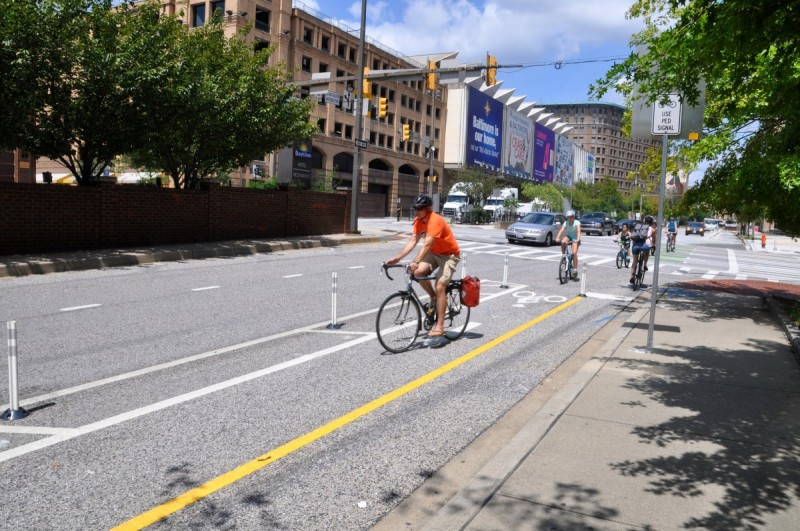The state of biking in Baltimore is bleak, but it’s brighter elsewhere in Maryland

Image by charmcity123 licensed under Creative Commons.
On February 14, 2018 Baltimore’s Board of Estimates voted to delay the city’s planned downtown bike network. This once-promising initiative has been floundering for over a year, and it’s not the first bike infrastructure initiative to peter out in the city.
While Baltimore seems resistant to promoting biking, surrounding counties and smaller cities have gone in the opposite direction and are boosting their cycling infrastructure. So why is Charm City moving in the wrong direction?
Baltimore’s bike commitment has fluctuated with different administrations
Baltimore City’s relationship with cycling has been steadily deteriorating since Mayor Sheila Dixon kicked off her campaign in 2006 (she was then City Council president) for what she envisioned as a bike-friendly Baltimore.
Under Dixon the city began making great strides, including developing a Bike Master Plan with its own bike planner. With her promises and commitment, a bike friendly-future seemed just around the corner. Baltimore City even received a bronze Bicycle Friendly Community award from the League of American Bicyclists, and was one of the first four Bicycle Friendly Communities in the state beside Bethesda, Frederick, and Rockville.
However, in the years since Dixon things have gone downhill in Baltimore, while the surrounding jurisdictions have improved.
Baltimore bikeshare bikes. Image by BeyondDC licensed under Creative Commons.
The Bicycle Master Plan stalled under Mayor Stephanie Rawlings-Blake, and the bicycle planner role became a part-time contractual position. But with the Bicycle Friendly Community renewal on the line and Bikemore and Bike Maryland working together, Rawlings-Blake ultimately came around on the benefits of investing in safe cycling infrastructure.
Work restarted on the bicycle network and the city took a chance with the Roland Avenue bikeway. They also installed the Maryland Avenue bikeway and moved forward with plans for Potomac Avenue. Baltimore also worked with the Mid-Atlantic Off Road Enthusiasts to reopen Loch Raven to mountain biking.
Unfortunately, the forward momentum that seemed to have finally arrived rapidly stalled upon Mayor Catherine Pugh’s inauguration late in 2016. The fight over Potomac Avenue first seemed like the normal “bikelash.” Plenty of neighborhoods get mad about a new bike lane, and the argument about emergency services has come up before. But the city applying fire clearance guidelines specifically to kill bike projects — while ignoring that same fire clearance for parking projects — is something else entirely.
Pugh seems to have drawn a line in the sand on bike projects. She refused to move the bicycle network forward, despite pressure from many residents who want to be able to get around the city safely.
Hopkins Place protected bikeway in Baltimore. Image by BeyondDC licensed under Creative Commons.
Neighboring jurisdictions are leading in promoting cycling
Antipathy towards cycling is not a regional phenomenon. In fact, as Baltimore goes backwards the surrounding suburban counties are making massive investments in bicycling infrastructure. Other areas including Columbia, Hagerstown, and Salisbury have been recognized as bike-friendly communities.
Earlier this month, Howard County announced a new $8 million investment to rapidly build out their bicycle network. This follows large investments from neighboring jurisdictions Anne Arundel and Montgomery counties, who respectively put $7.5 million and $26 million into their latest bike budgets.
Large cities, with their greater density, find it easier to build a sustainable bicycle network. Nonetheless, it’s Maryland’s suburban counties and small cities that are taking the lead in building safe road networks for their residents.
